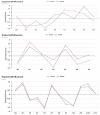Psychological State Among the General Chinese Population Before and During the COVID-19 Epidemic: A Network Analysis
- PMID: 33716811
- PMCID: PMC7952988
- DOI: 10.3389/fpsyt.2021.591656
Psychological State Among the General Chinese Population Before and During the COVID-19 Epidemic: A Network Analysis
Abstract
Background: The infectious disease Coronavirus Disease 2019 (COVID-19) outbroke in 2019 spread to multiple countries. The quick spread of the virus and isolation strategies may trigger psychological problems. Our aim was to explore the dynamic network structure of the psychological state before and during the epidemic. Methods: A web-based survey was conducted in two stages: the T1 stage (1 January 2019 to 31 December 2019) and the T2 stage (1 February 2020 to 8 March 2020). In both stages, the Patient Health Questionnaire-9, General Anxiety Disorder-7, and Pittsburgh Sleep Quality Index were used to assess depression, anxiety, and sleep, respectively. Results: We matched the data based on IP addresses. We included 1,978, 1,547, and 2,061 individuals who completed the depression, anxiety, and sleep assessments, respectively, at both stages. During epidemics, psychomotor agitation/retardation, inability to relax, restless behavior, and the frequency of using medicine had high centrality. Meanwhile, the network structure of psychological symptoms becomes stronger than before the epidemic. Conclusion: Symptoms of psychomotor agitation/retardation, inability to relax, and restless behavior should be treated preferentially. It is necessary to provide mental health services, including timely and effective early psychological intervention. In addition, we should also pay attention to the way patients use medicines to promote sleep quality.
Keywords: COVID-19; general population; longitudinal study; network analysis; psychological state.
Copyright © 2021 Ge, Zheng, Wan, Luo and Zhang.
Conflict of interest statement
The authors declare that the research was conducted in the absence of any commercial or financial relationships that could be construed as a potential conflict of interest.
Figures




Similar articles
-
Perceived psychological stress and associated factors in the early stages of the coronavirus disease 2019 (COVID-19) epidemic: Evidence from the general Chinese population.PLoS One. 2020 Dec 4;15(12):e0243605. doi: 10.1371/journal.pone.0243605. eCollection 2020. PLoS One. 2020. PMID: 33275635 Free PMC article.
-
Immediate Psychological Responses and Associated Factors during the Initial Stage of the 2019 Coronavirus Disease (COVID-19) Epidemic among the General Population in China.Int J Environ Res Public Health. 2020 Mar 6;17(5):1729. doi: 10.3390/ijerph17051729. Int J Environ Res Public Health. 2020. PMID: 32155789 Free PMC article.
-
The correlation between lifestyle health behaviors, coping style, and mental health during the COVID-19 pandemic among college students: Two rounds of a web-based study.Front Public Health. 2023 Jan 12;10:1031560. doi: 10.3389/fpubh.2022.1031560. eCollection 2022. Front Public Health. 2023. PMID: 36711327 Free PMC article.
-
A systematic review and meta-analysis on prevalence of and risk factors associated with depression, anxiety and insomnia in infectious diseases, including COVID-19: a call to action.Mol Psychiatry. 2022 Aug;27(8):3214-3222. doi: 10.1038/s41380-022-01638-z. Epub 2022 Jun 6. Mol Psychiatry. 2022. PMID: 35668158 Free PMC article.
-
Psychological impact on healthcare workers, general population and affected individuals of SARS and COVID-19: A systematic review and meta-analysis.Front Public Health. 2022 Nov 4;10:1004558. doi: 10.3389/fpubh.2022.1004558. eCollection 2022. Front Public Health. 2022. PMID: 36407973 Free PMC article.
Cited by
-
Network Analysis of Depressive Symptoms Among Residents of Wuhan in the Later Stage of the COVID-19 Pandemic.Front Psychiatry. 2021 Sep 30;12:735973. doi: 10.3389/fpsyt.2021.735973. eCollection 2021. Front Psychiatry. 2021. PMID: 34658968 Free PMC article.
-
Public interest and awareness regarding general health, sleep quality and mental wellbeing during the early COVID-19 pandemic period: An exploration using Google trends.Sleep Epidemiol. 2022 Dec;2:100017. doi: 10.1016/j.sleepe.2021.100017. Epub 2021 Nov 20. Sleep Epidemiol. 2022. PMID: 35673330 Free PMC article.
-
Changes in sleep quality and sleep disturbances in the general population from before to during the COVID-19 lockdown: A systematic review and meta-analysis.Front Psychiatry. 2023 Apr 13;14:1166815. doi: 10.3389/fpsyt.2023.1166815. eCollection 2023. Front Psychiatry. 2023. PMID: 37124253 Free PMC article.
-
Temporal network of experience sampling methodology identifies sleep disturbance as a central symptom in generalized anxiety disorder.BMC Psychiatry. 2024 Mar 29;24(1):241. doi: 10.1186/s12888-024-05698-z. BMC Psychiatry. 2024. PMID: 38553683 Free PMC article.
-
Relationships between childhood trauma and mental health during the COVID-19 pandemic: a network analysis.Front Psychiatry. 2023 Sep 8;14:1251473. doi: 10.3389/fpsyt.2023.1251473. eCollection 2023. Front Psychiatry. 2023. PMID: 37743981 Free PMC article.
References
LinkOut - more resources
Full Text Sources
Other Literature Sources

